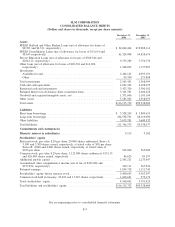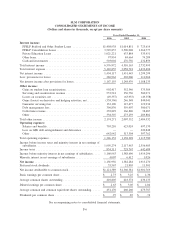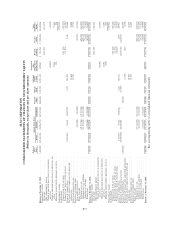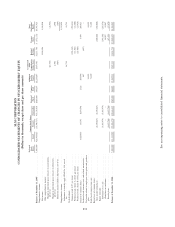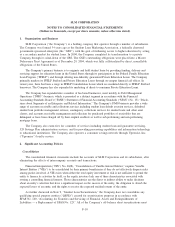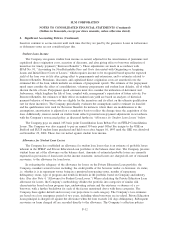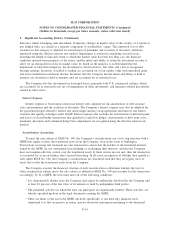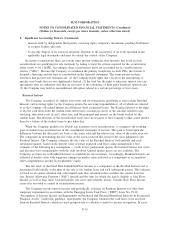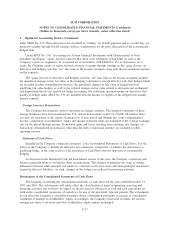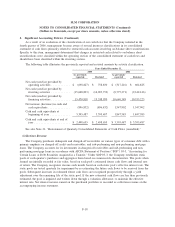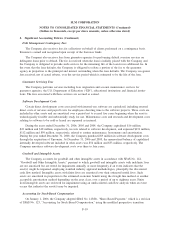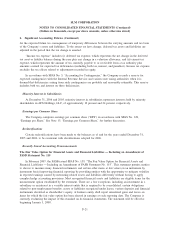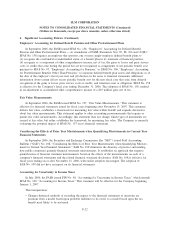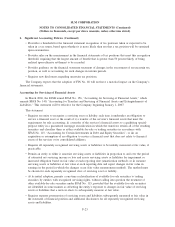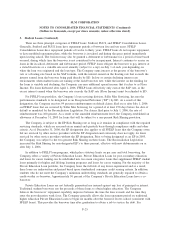Sallie Mae 2006 Annual Report Download - page 134
Download and view the complete annual report
Please find page 134 of the 2006 Sallie Mae annual report below. You can navigate through the pages in the report by either clicking on the pages listed below, or by using the keyword search tool below to find specific information within the annual report.2. Significant Accounting Policies (Continued)
interests held by independent third parties, servicing rights, temporary investments pending distribution
to security holders and cash.
• It can only dispose of its assets in automatic response to the occurrence of an event specified in the
applicable legal documents and must be outside the control of the Company.
In certain securitizations there are certain terms present within the deal structure that result in such
securitizations not qualifying for sale treatment by failing to meet the criteria required for the securitization
entity (trust) to be a QSPE. Accordingly, these securitization trusts are accounted for as variable interest
entities (“VIEs”). Because the Company is considered the primary beneficiary in such VIEs, the transfer is
deemed a financing and the trust is consolidated in the financial statements. The terms present in these
structures that prevent sale treatment are: (1) the Company holds rights that can affect the remarketing of
specific trust bonds that are not significantly limited, (2) the trust has the right to enter into interest rate cap
agreements after its settlement date that do not relate to the reissuance of third party beneficial interests and
(3) the Company may hold an unconditional call option related to a certain percentage of trust assets.
Retained Interest
The Company securitizes its student loan assets and for transactions qualifying as sales retains Residual
Interests and servicing rights (as the Company retains the servicing responsibilities), all of which are referred
to as the Company’s Retained Interest in off-balance sheet securitized loans. The Residual Interest is the right
to receive cash flows from the student loans and reserve accounts in excess of the amounts needed to pay
servicing, derivative costs (if any), other fees, and the principal and interest on the bonds backed by the
student loans. The investors of the securitization trusts have no recourse to the Company’s other assets should
there be a failure of the student loans to pay when due.
When the Company qualifies for GAAP sale treatment on its securitizations, it recognizes the resulting
gain on student loan securitizations in the consolidated statements of income. This gain is based upon the
difference between the allocated cost basis of the assets sold and the relative fair value of the assets received.
The component in determining the fair value of the assets received that involves the most judgment is the
Residual Interest. The Company estimates the fair value of the Residual Interest, both initially and each
subsequent quarter, based on the present value of future expected cash flows using management’s best
estimates of the following key assumptions — credit losses, prepayment speeds, the forward interest rate curve
and discount rates commensurate with the risks involved. Quoted market prices are not available. The
Company accounts for its Residual Interests as available-for-sale securities. Accordingly, Residual Interests are
reflected at market value with temporary changes in market value reflected as a component of accumulated
other comprehensive income in stockholders’ equity.
The fair value of the Fixed Rate Embedded Floor Income is a component of the Residual Interest and is
determined both initially at the time of the sale of the student loans and each subsequent quarter. This estimate
is based on an option valuation and a discounted cash flow calculation that considers the current borrower
rate, Special Allowance Payment (“SAP”) spreads and the term for which the loan is eligible to earn Floor
Income as well as time value, forward interest rate curve and volatility factors. Variable Rate Floor Income
received is recorded as earned in securitization income.
The Company records interest income and periodically evaluates its Residual Interests for other than
temporary impairment in accordance with the Emerging Issues Task Force (“EITF”) Issue No. 99-20
“Recognition of Interest Income and Impairment on Purchased and Retained Beneficial Interests in Securitized
Financial Assets.” Under this guidance, each quarter, the Company estimates the cash flows to be received
from its Residual Interests which are used prospectively to calculate a yield for income recognition. In cases
F-15
SLM CORPORATION
NOTES TO CONSOLIDATED FINANCIAL STATEMENTS (Continued)
(Dollars in thousands, except per share amounts, unless otherwise stated)


